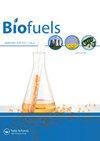利用硅砂衍生的KOH/ hy型纳米催化剂从废食用油中制备生物柴油
IF 2.6
4区 工程技术
Q3 ENERGY & FUELS
引用次数: 0
摘要
摘要采用水热法制备了一种y型纳米沸石催化剂,以伊拉克砂土为原料,制备了一种低成本、易得的催化剂。对催化剂加装氢氧化钾前后进行了测试。采用不同粒径(75、600和1000 μm)的y -催化剂,在不同温度(40、50和60℃)和3 h反应时间的间歇式反应器中进行了实验。结果表明,在KOH不促进的情况下,提高反应温度和反应时间,转化率和产率均有所提高,分别达到55.56%和33.33%。然而,用10%的KOH分子促进催化剂后,转化率和产率显著提高。结果表明,生物柴油的最佳转化率和产率分别为86.67%和82.22%。反应温度为60℃,反应时间为2 h,催化剂粒径为75 μm, KOH浓度为10%。使用装载低百分比碱的多相催化剂有助于免除使用含有高百分比碱的均相催化剂。关键词:催化酯交换反应生物柴油替代燃料koh / hy型纳米催化剂替代纳米二氧化硅致谢作者感谢伊拉克理工大学化学工程系和纳米技术与先进材料研究中心的科学支持。披露声明作者未报告潜在的利益冲突。本研究由悉尼科技大学通过战略研究支持基金资助,资助号(324100.2200034)。本文章由计算机程序翻译,如有差异,请以英文原文为准。
Biodiesel production from waste cooking oil using KOH/HY-type nano-catalyst derived from silica sand
AbstractThe present study aimed to synthesize a Y-nanozeolite catalyst using the hydrothermal method and Iraqi sand-derived silica as a low-cost and readily available raw material. The catalyst was tested before and after loading with potassium hydroxide (KOH). The experiments were conducted in a batch reactor under different temperatures (40, 50, and 60 °C) and a 3-h reaction time, using the prepared Y-catalyst with three different particle sizes (75, 600, and 1000 μm). The results showed that increasing the temperature and/or reaction time generally resulted in increased conversion and yield when the catalyst was unpromoted with KOH, reaching a range of 55.56% and 33.33%, respectively. However, a significant increase in the conversion and yield was observed after promoting the catalyst with 10% KOH molecules. The optimal conditions for achieving the highest conversion and yield of biodiesel were determined to be 86.67% and 82.22%, respectively. These conditions involved a temperature of 60 °C, a reaction time of 2 h, and the use of a catalyst with a particle size of 75 μm loaded with 10% KOH. The use of a heterogeneous catalyst loaded with the base in a low percentage helps to dispense with the use of homogeneous catalysts with a high percentage of bases.Keywords: Catalytic transesterification reactionbiodieselalternative fuelKOH/HY-type nano-catalystalternative nano silica AcknowledgmentsThe authors thankfully acknowledge scientific support of Department of Chemical Engineering and the Nanotechnology and Advanced Material Research Center, University of Technology-Iraq, Baghdad, Iraq.Disclosure statementNo potential conflict of interest was reported by the authors.Additional informationFundingThis research was funded by University of Technology Sydney through Strategic Research Support funding with grant number (324100.2200034).
求助全文
通过发布文献求助,成功后即可免费获取论文全文。
去求助
来源期刊

Biofuels-Uk
Energy-Renewable Energy, Sustainability and the Environment
CiteScore
5.40
自引率
9.50%
发文量
56
期刊介绍:
Current energy systems need a vast transformation to meet the key demands of the 21st century: reduced environmental impact, economic viability and efficiency. An essential part of this energy revolution is bioenergy.
The movement towards widespread implementation of first generation biofuels is still in its infancy, requiring continued evaluation and improvement to be fully realised. Problems with current bioenergy strategies, for example competition over land use for food crops, do not yet have satisfactory solutions. The second generation of biofuels, based around cellulosic ethanol, are now in development and are opening up new possibilities for future energy generation. Recent advances in genetics have pioneered research into designer fuels and sources such as algae have been revealed as untapped bioenergy resources.
As global energy requirements change and grow, it is crucial that all aspects of the bioenergy production process are streamlined and improved, from the design of more efficient biorefineries to research into biohydrogen as an energy carrier. Current energy infrastructures need to be adapted and changed to fulfil the promises of biomass for power generation.
Biofuels provides a forum for all stakeholders in the bioenergy sector, featuring review articles, original research, commentaries, news, research and development spotlights, interviews with key opinion leaders and much more, with a view to establishing an international community of bioenergy communication.
As biofuel research continues at an unprecedented rate, the development of new feedstocks and improvements in bioenergy production processes provide the key to the transformation of biomass into a global energy resource. With the twin threats of climate change and depleted fossil fuel reserves looming, it is vitally important that research communities are mobilized to fully realize the potential of bioenergy.
 求助内容:
求助内容: 应助结果提醒方式:
应助结果提醒方式:


